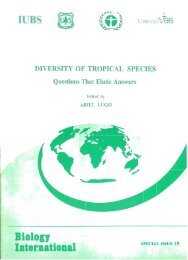SPECIAL ISSUE 34a.pdf - Biology International
SPECIAL ISSUE 34a.pdf - Biology International
SPECIAL ISSUE 34a.pdf - Biology International
Create successful ePaper yourself
Turn your PDF publications into a flip-book with our unique Google optimized e-Paper software.
<strong>Biology</strong> <strong>International</strong>, Special Issue NO. 34 (1 997)<br />
bionomenclature terminology might also be used. If this is done, then there is<br />
every likelihood that this terminology could also be adopted in the edition of the<br />
ICBN that is to be expected following the XVI <strong>International</strong> Botanical Congress<br />
to be held in St. Louis in August 1999.<br />
1 believe, however, that more needs to be done in this area. A DraJt Glossary of<br />
Terms used in BionomencIature (Hawksworth et al., 1994b) was deliberately<br />
presented as an integrated list but without any value judgements on preferred<br />
terms. The tables of equivalents discussed above includes key recornrnended<br />
terms, but there are other terms, and, more particularly, other usages of terms,<br />
that are differentially preferred by botanical or zoological nomenclaturalists or<br />
are used in different senses by the two groups. The phrase "specific name" when<br />
used by zoologists implies the "specific epithet" of botanists, whereas a "speci-<br />
fic name" to a botanist is a "binomen" to a zoologist. This is not solely a matter<br />
of terminology, but also a matter of nomenclatural actions being expressed in<br />
ways that reflect some of the conceptual differences between the Codes that are<br />
discussed below. The discussion by Melville (1 986) of "nominal taxa" is a good<br />
example of divergent philosophy encompassing divergent terminology. Perhaps<br />
a revision of the Drap Glossary that took account of differing philosophy and<br />
that did seek to make recomrnendations would be a goal for which to aim.<br />
(b) Form of names and author citations<br />
The form of names, and the form of author citations associated with narnes,<br />
although prescribed to a greater or lesser extent in al1 the Codes, are, relatively<br />
speaking, details which should not be fundamental to any integration of<br />
biological nomenclature. Nevertheless, despite the fact that they are essentially<br />
details within the Codes, they tend to generate strongly held views and<br />
consequent controversy. They are, indeed, one of the components of biological<br />
nomenclature that most need to be explained to users (cf. McNeill & Barkworth,<br />
1996).<br />
(i) Terminations<br />
The differing terminations ("suffixes" in the ICZN, which reserves "termination"<br />
to describe modification to epithets to ensure agreement in gender) for the same<br />
rank (e.g. -aceae for botanical and bacteriological families and -idae for<br />
zoological ones) can be confusing for beginning students and the situation in<br />
which the same termination is used for different ranks under the different Codes<br />
(e.g. -inae for subtribes under the ICBN and the BC, and for subfamilies under<br />
the ICZN, as well as the former's use -idae for subclasses of plants) is perhaps<br />
even more so - see discussion and proposals by Greuter in this Symposium.<br />
Fundarnentally, however, they are not major obstacles to a simple, integrated<br />
BioCode.<br />
(ii) Italicization<br />
The question of how to distinguish scientific names from other text, e.g. by<br />
italicization, and the ranks of names to be so distinguished, is not directly




